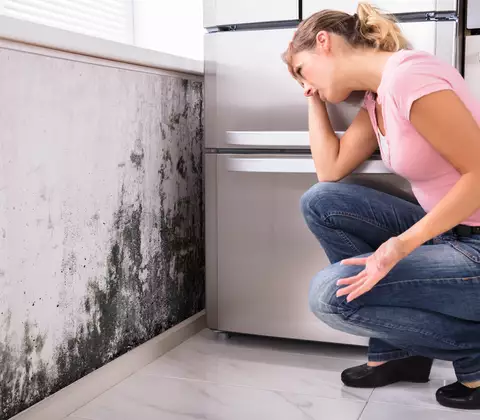
Here’s how to prevent mould in your building
Over 40% of people say they have mould in their home. One of the reasons why mould is so prevalent is the fact that a lot of houses are extremely well insulated. Mould is also a frequent point of contention between tenants and landlords. Read on to find out what leads to mould in your home and what you can do to keep your home safe.
Mould can also affect your health
You probably won’t know you have mould in your home until you see black spots forming on your wall or ceiling. But the health impact of mould is much worse than its ugly appearance.
Mould spores get into your home in the air. If they find the food, heat and moisture they need, your mould problem can get out of hand pretty quickly. Mould feeds on organic substances like wood, plasterboard, carpets, wallpaper, dust and even your clothes. Mould will start to spread if the temperature is nice and warm and the air humidity is 80% or higher. This will cause more spores to spread around your home in the air.
These spores are extremely small and are very easy to breathe in. They can cause respiratory infections, coughs and runny noses.
They can even trigger chronic illnesses in people with allergies, asthma or a weakened immune system.
What part of your home is most susceptible to mould?
Mould will grow anywhere with enough moisture. Your bathroom and shower will be the main culprits, but kitchens and bedrooms are also prime environments for mould. Showering and having a bath release a lot of moisture into the air. Try and get rid of it as soon as you can.
You can do this by ventilating on a regular basis and mopping up condensation. Cooking also releases moisture into the air.
You can use an extractor fan to get rid of it. The bedroom is where we spend the majority of our time. Each person puts around 1.5 litres of water into the air per night.

How to prevent mould
Ventilating properly to prevent mould
Mould loves moisture - ventilate your home on a regular basis to get rid of it. The best approach to take depends on the time of year and the room in question. Opening your windows as wide as they go a few times a day is usually the best approach. Leaving your windows open a crack won’t be effective or efficient, particularly in winter.
However, open windows on a hot and humid day can actually let more moist air in. Keep your doors closed so that you don’t let humid air and mould get to other areas of your home.
Heating your home properly to prevent mould
Ventilating properly isn’t enough to prevent mould in your home in winter. You also need to heat your home the right way. Don’t set your heating too low - it should be set to at least 18°C – even in rooms which you hardly ever use.
That’s because warm air absorbs more moisture than cold air.
Condensation forms when the air in a room can’t hold any more moisture This provides the ideal conditions for mould to form.
Make sure that you open your windows as wide as they will go on a regular basis, even in winter. In addition to combating mould, this will also reduce your heating costs.
Setting your home up to prevent mould
You can set your home up in a way that makes sure that air can circulate freely. This will prevent moisture and cold zones. Here’s how you do it:
- Leave a few centimetres between large pieces of furniture and the wall. This will let the air circulate freely behind your furniture. Doing this is particularly important in new builds, which will still have a little moisture left in them.
- Sofas and similar furniture should be positioned next to an internal wall, because they’re warmer than external walls. Also, your radiators are likely to be on an external wall. Doing this allows the air in your home to circulate freely and distributes heat evenly.
- Do you have cold bridges in your home? These are areas which are quicker to get cold than elsewhere. Insulate your radiator niches and roller blind housings to remove cold bridges from your home.
- Make sure that all of your windows and doors shut fully.
Mechanical ventilation
CWL-2
The most compact in its class, extremely quiet and highly efficient – the new CWL-2 series from WOLF.

What to do if you have mould in your home
Remove small areas of mould quickly and thoroughly before it has a chance to spread. Apply vinegar and methylated spirit to the mouldy area and let them work for a while, then brush the area thoroughly.
Use a chlorine-based cleaning product for the grout in your bathroom. Remove any dust and dirt from the affected grout first, then spray the area with cleaner and leave it for 24 hours before wiping with a cloth and clean water. This will remove any discoloration from your grout along with any mould.
If these methods fail to remove the mould, contact a specialist through a consumer advice centre. You should also contact an expert if you feel like you have mould in your home but can’t see it. These specialists will have a lot of experience in dealing with mould and will use equipment to detect high levels of mould spores.


